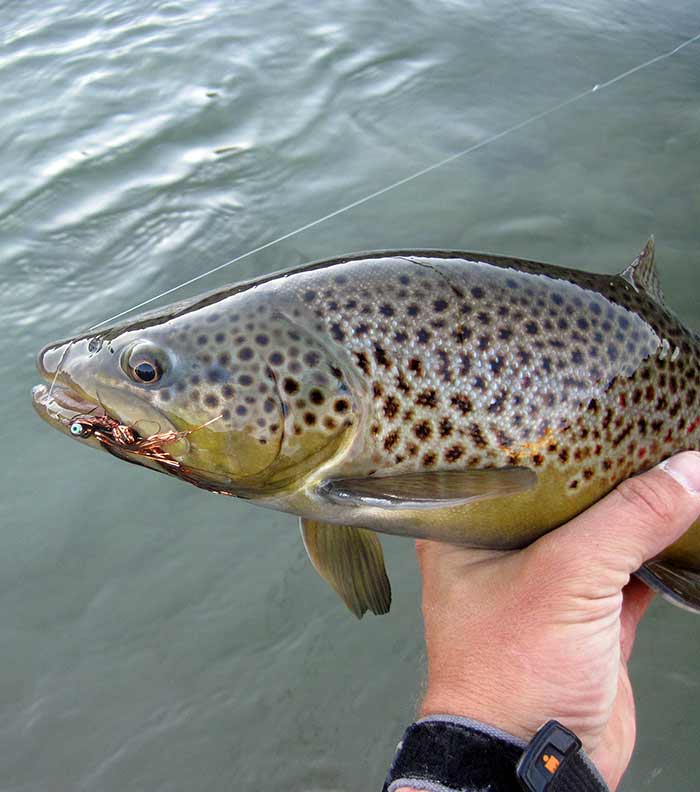Hike, scramble, and wade to a great time on our walk & wade Montana and Yellowstone Park fishing trips
Walk and wade fly fishing trips in Yellowstone Park offer a wide range of experiences for anglers of any skill level. Over the space of a single day of guided fly fishing in Yellowstone, we might catch as many as four trout species, plus Arctic grayling and whitefish. We catch these fish in everything from raging canyon rivers to tiny creeks that look like they could come from your garden hose.
Options for wade fishing in Montana are a bit more limited, but they offer excellent chances at big fish in early spring and late fall. During the summer, a few odds and ends on both famous rivers and out-of-the-way creeks offer great opportunities both to beat the heat and the crowds. Our private water wade trips on the Paradise Valley spring creeks are discussed separately.
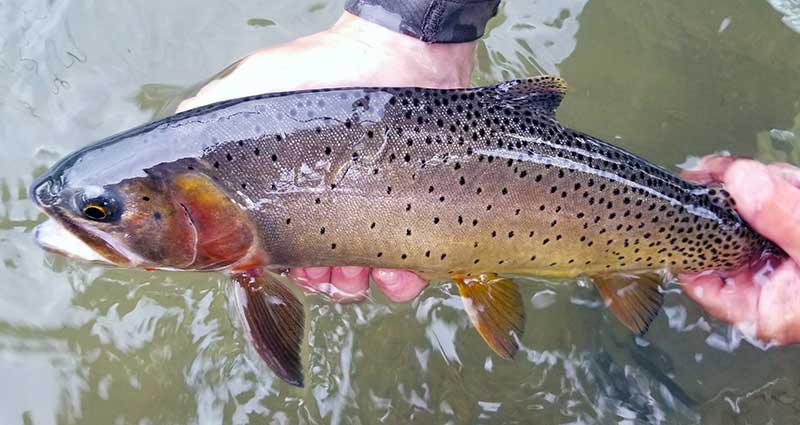
Yellowstone Park fishing trips are ideal for anglers interested in targeting native cutthroat trout.
Walk & Wade Trips: Who, When, and Where?
Our walk & wade fly fishing trips in Yellowstone Park and Montana are ideal for the following clients:
- beginners
- clients of any skill level who want to focus on learning or improving their fly fishing tactics
- visitors who prefer a slower-paced day
- eager hikers
- and those eager to enjoy the scenery, the wildlife, and the geologic wonders the region has to offer as much (or almost as much) as the fishing.
Because our river rocks are slippery, the banks often steep, and the walks into our fishing areas sometimes long, they aren’t ideal for anglers in poor physical condition or those who don’t wish to hike.
Walk and wade trips in Montana are available year-round, though options are very limited during the spring melt season in May and June. The best guided wade-fishing in Montana takes place outside of prime tourist season: from January through early April in particular. There are some sneaky summer options for fit anglers as well.
Walk and wade trips are available in Yellowstone National Park during the park’s entire open season: Memorial Day Weekend in late May through October 31. Good options are available during this entire period, but the widest variety of fisheries are available from early July through September, exactly when guided wade trips in Montana aren’t as good.
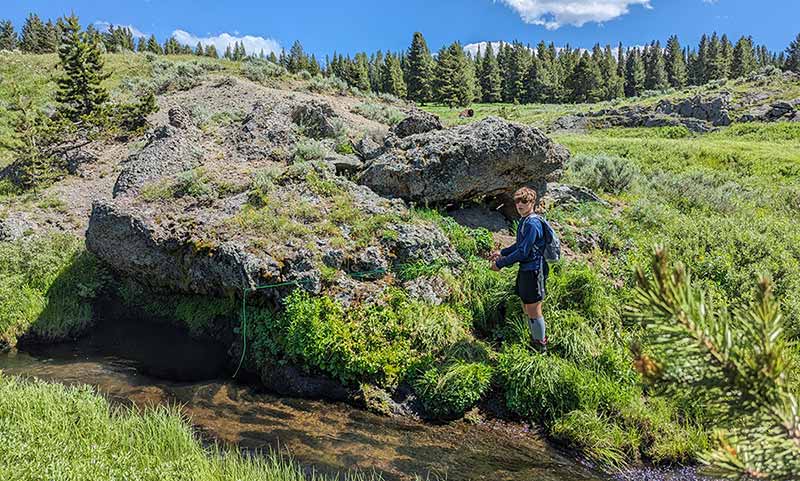
Sometimes we fish with an audience on Yellowstone Park fishing trips. Note the critter in the background.
Walk and Wade Fishing Trips or Hike and Wade Trips?
Roadside waters in Yellowstone see extreme fishing pressure. In our opinion, there’s enough pressure it hurts the experiences we can provide our clients.
For this reason, most of our wade fishing trips in Yellowstone Park involve a hike of half a mile to four miles one-way, often in rugged terrain with fast water once we get to our destination. Burning some boot leather produces more fish that are in better condition than those near the road–and it enables our Yellowstone fishing guides to show our guests “the real Yellowstone.”
Don’t let this scare you. We routinely take children aged 10-12 as well as folks over age 70 on short hikes that put us on water where we don’t see any other anglers all day. For teens and adults eager to do some exploring, there’s an infinite number of options, from tiny mountain creeks on up to the raging Grand Canyon of the Yellowstone River.
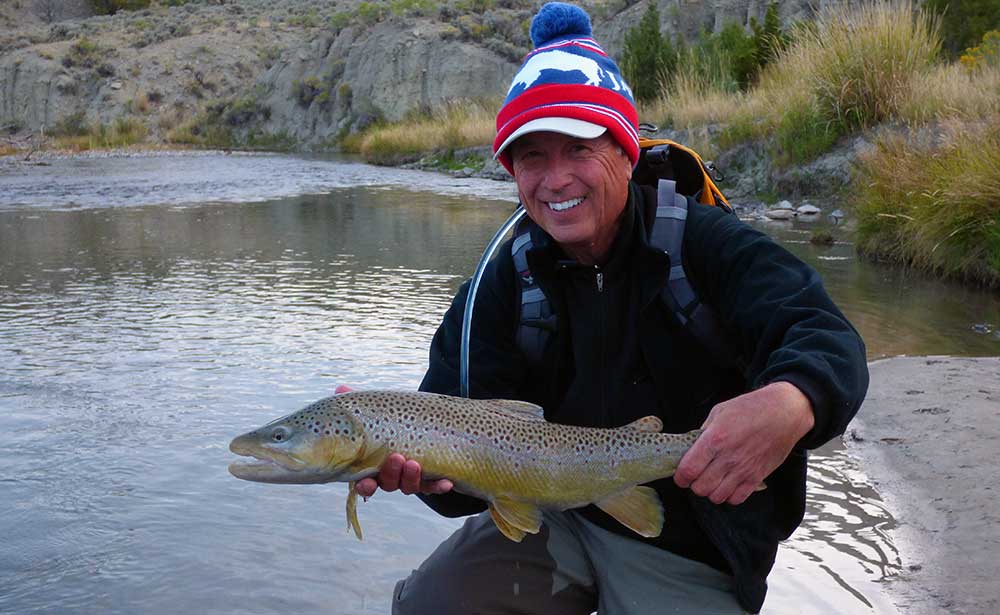
It’s hard to argue with the appeal of large brown trout.
2024 Walk & Wade Trip Rates and Notes
Walk & Wade trips are available as full-day, half-day, and winter quarter-day trips. For practical purposes, most walk trips in Montana are half-days or shorter, while most in Yellowstone Park are full-days.
- Full-Day Yellowstone Park Wade Trips: $675 for one or two anglers. Available late May through October.
- Half-Day Yellowstone Park Wade Trips: $550 for one or two anglers. Available late May through October.
- Half-Day Montana Wade Trips: $525 for one or two anglers. Available late February through Thanksgiving.
- Winter Special 3hr Montana Wade Trips: $375 for one or two anglers. Available November 1 through March. Yellowstone River only.
- Standard terms apply.
On Yellowstone Park fishing trips, guests will need to pay Yellowstone Park entrance fees as well as have Yellowstone Park fishing licenses. Our commercial entrance permits do not cover our passengers.
We’ll meet in Livingston, near/at your lodgings, or near our fishing destination, whichever makes more sense.
Wade Trips: Season by Season
The places we fish and the experiences our guests have change more radically on wade trips over the course of the season than on any of our other guided trips. Click the bold-face links at the head of each section below for more details on where and how we fish at different times of year, as well as plenty more photos.
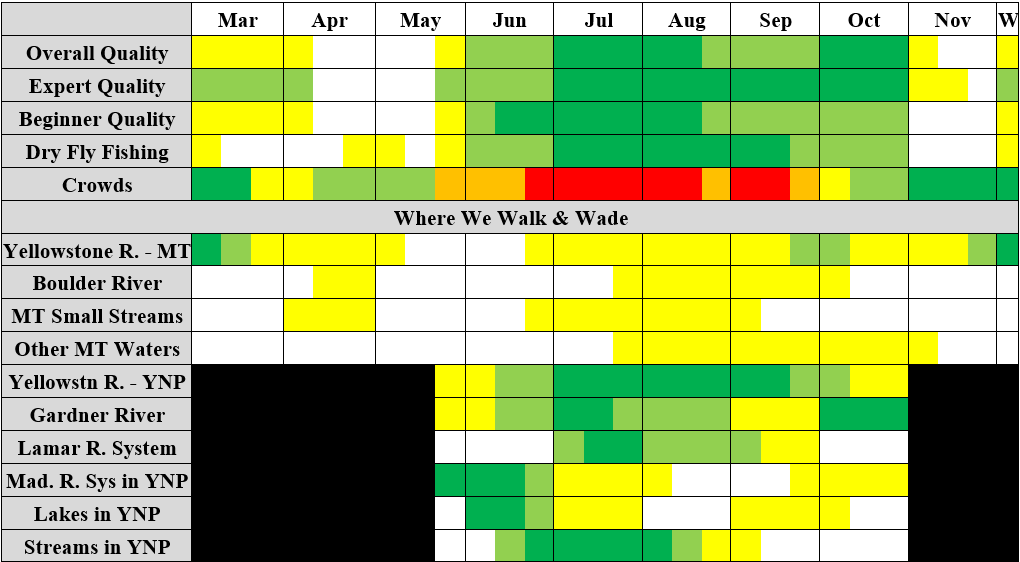
Winter and Early Spring Wade Trips (Late November through April)
While it isn’t for the faint-hearted, excellent wade-fishing occurs on the Yellowstone River throughout the winter. The best fishing is near Gardiner, just north of Yellowstone Park. Our winter special trips are specifically intended for this fishing and are the only public water trips we run at this time. This fishing isn’t beginner-friendly, but it is often very good.
From late November through early January is the doldrums. We fish nymphs and perhaps streamers in the warmest part of the day. As the days get longer in late January and February, we’re looking for numbers of trout feeding on midges. The dry fly fishing can actually be excellent whenever temperatures are near freezing.
By March, larger fish become active. The largest rainbows and cutt-bows of the season are caught in March and April. Our owner Walter Wiese caught the fish in the photo and its twin within half an hour of one another in late March a few years ago.
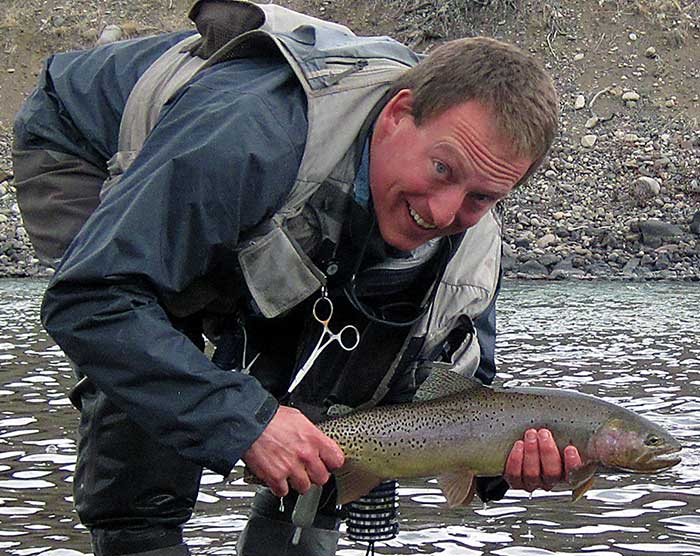
Late Spring Yellowstone Fishing Trips: Late May through the End of Runoff
Yellowstone National Park’s fishing season opens the Saturday of Memorial Day Weekend. For the first two to four weeks of the season, most waters in the park are in the midst of the spring melt, and the weather can be frightful. It’s not uncommon for it to snow anytime until mid-June.
Yellowstone Park has two secret weapons, though: rivers that drain geyser basins and several excellent hike-in lakes. The geothermal rivers fish better in late spring than any other time, while the lakes become fishable sometime in the first ten days of the season, providing excellent fishing for some of the rarest fish in the area: Arctic grayling.
The park has by far the region’s best wade-fishing opportunities in late May and June. As such, it’s the only place we run public water wade trips at this time. The fishing is suitable for almost all clients, from beginners to experts. We generally suggest clients ages 12+ at this time, though, because the wading is usually difficult due to high water.
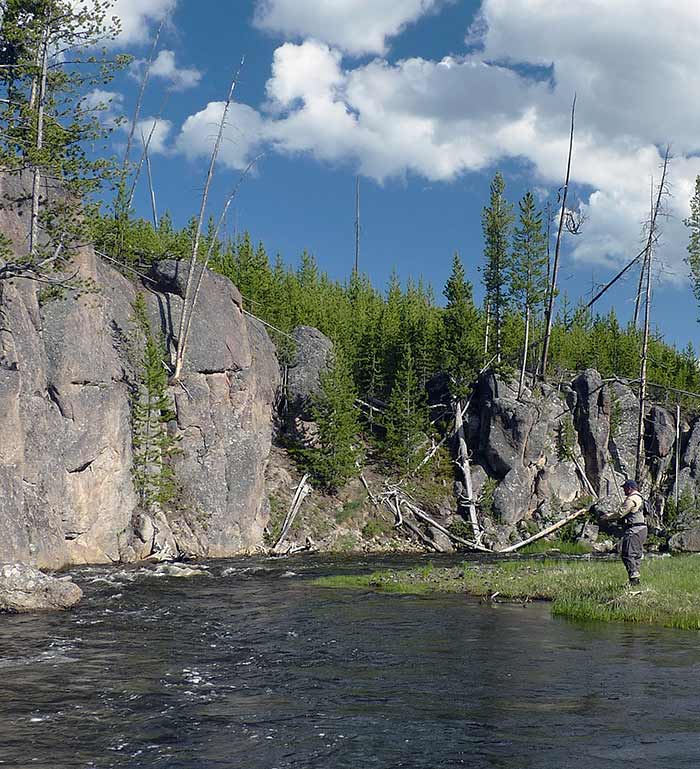
The Gibbon River (pictured) is geyser-fed and a prime destination in early June.
Early Summer Montana and Yellowstone Fly Fishing Trips: The End of Runoff through July
Waters across the northern part of Yellowstone Park drop out of runoff between mid-June and early July. For the next month to six weeks, these rivers and streams produce excellent fishing for anglers of all skill levels and interests. Beginners in particular should consider this period. Late June through July offers by far the best beginner wade-fishing options of the year.
A wealth of Yellowstone fishing trip options are available at this time, from tiny trickles you could step across that hold jewel-like native cutthroat trout and grayling on up to the raging Yellowstone River in its Grand and Black Canyons. This is definitely peak season for anglers interested in large cutthroat trout, especially cutthroat trout gorging on the region’s famous Salmonfly hatches. These hatches are better in the park than anywhere else in our operations area.
The park’s top insect hatches occur at this time and the trout are fat and sassy, which is why early summer is the most popular time for visitors to fish the park. Tourist crowds both on the roads and on streams near the roads tend to be very high. For this reason, our Yellowstone Park fishing guides strongly prefer hike-in fisheries at this time.
Wade-fishing on public waters in Montana is much more demanding since flows are still high, but there are good options for fit anglers who don’t want to fight the park’s crowds.
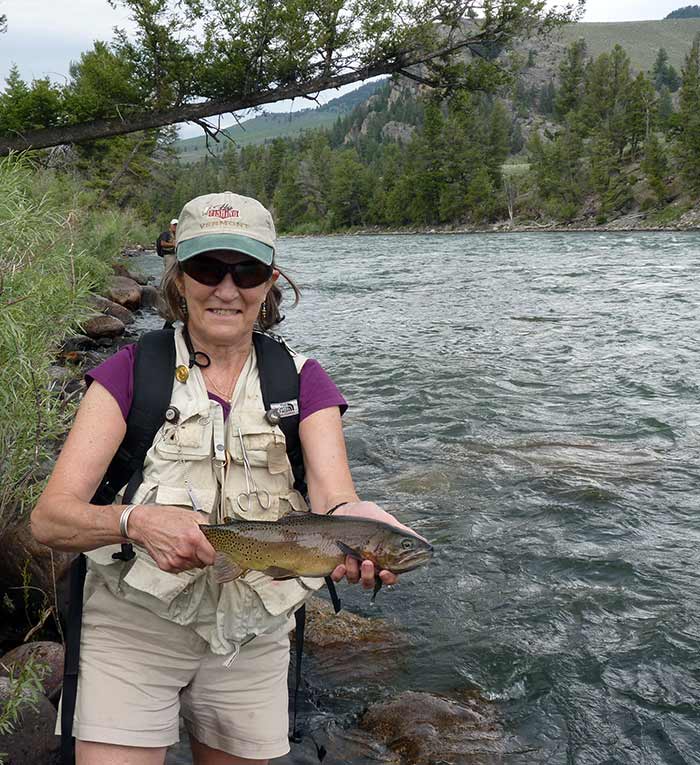
Late Summer Montana and Yellowstone Fly Fishing Trips: August and Early September
Rivers and streams in Yellowstone Park get low and clear in late summer and insect hatches decline, but the hatches are replaced by terrestrial bugs like grasshoppers and ants.
With slower water comes slower, more deliberate fishing in many places, along with much easier wading, though the Yellowstone River and several other fast-flowing areas continue to fish well on large flies for aggressive anglers who like to rock-hop.
As the nights grow longer and cooler in late August, the first hints of fall appear and fall-run browns begin their spawning migrations. We often see our largest pre-spawn browns when the calendar (and the daytime weather) still says it’s summer. We can even see the first fall Blue-winged Olive hatches in mid-August, a solid three weeks earlier than they tend to pop on our float trips at lower elevations.
Because of the lower flows that make wading easier and limit boat traffic on some smaller rivers, late summer is a better time for wade-fishing in Montana than earlier in the summer.
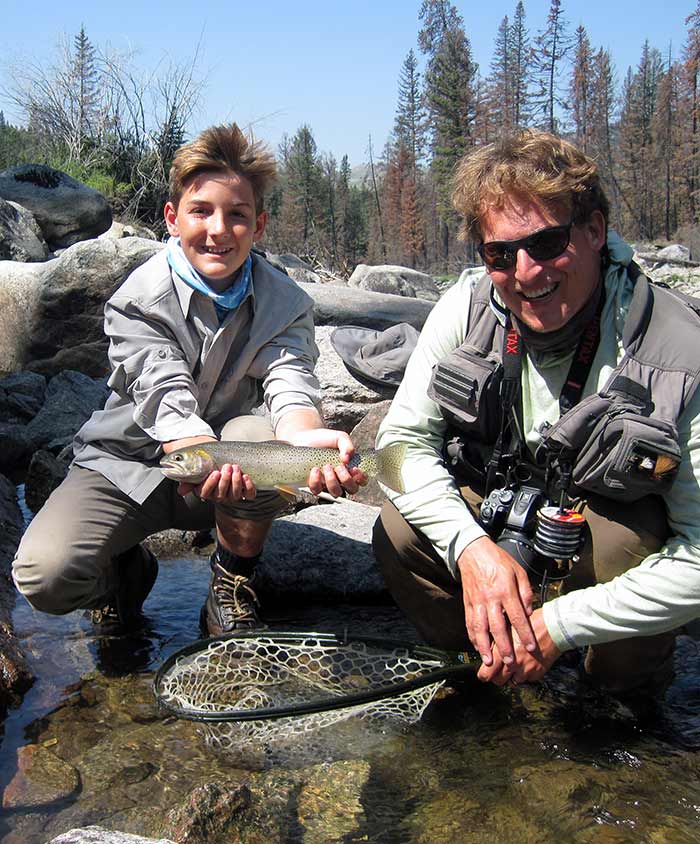
Early Autumn Montana and Yellowstone Fly Fishing Trips: September and Early October
Sometime in early September frost starts appearing most mornings and cold rains or snow flurries might greet us if the weather turns ugly. When the weather turns, the number of prime fisheries across the northern part of Yellowstone Park starts to decline. Those that remain (mostly bigger rivers) often produce their best fishing of the year, however.
On all rivers that continue to fish well, fall hatches intensify, and the trout can now be tough and spooky, challenging anglers to a battle of wits. In the meantime, fall-run brown trout numbers continuously increase, while angler crowds continuously decline except on the brown trout rivers, where they often actually get worse. That’s a good argument for hitting rivers like the Yellowstone in its canyons, which the crowds tend to ignore despite awesome streamer fishing and hatches.
Fewer walk-wade opportunities are available in Montana than in late summer, but those that remain are usually even less crowded and even better. Often the Yellowstone River right through Gardiner can produce well for wade-anglers, since there are now few, if any boats to fight.
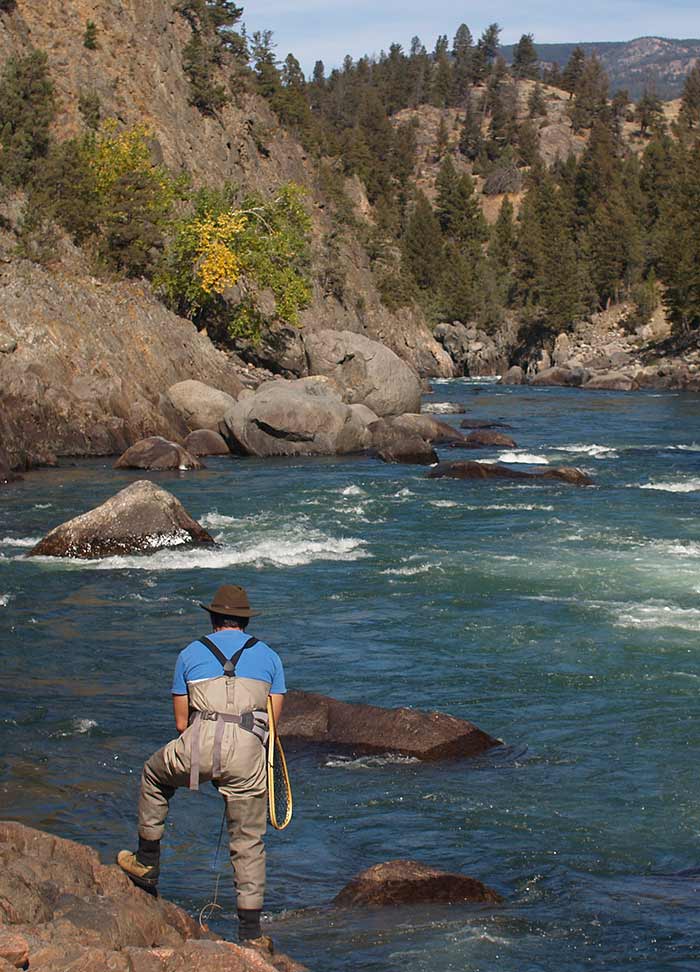
Angler fishing the Black Canyon of the Yellowstone in September
Late Autumn Montana and Yellowstone Fly Fishing Trips: October and Early November
Late fall begins around the beginning of October, after which most nights are below freezing and heavy snows are possible. Options inside Yellowstone Park narrow to rivers that receive fall-run brown trout, geyser-warmed rivers, and the mighty Yellowstone. These options are fantastic, though, with good chances at both heavy (but usually spotty) hatches as well as the year’s best brown trout fishing.
Fall-run browns consume the attention of most anglers in Yellowstone Park in late fall, and we’re not immune to the siren call of big, aggressive trout. Here’s a sneaky fact, though: the closer to the end of the season we get, the more chunky and healthy rainbow and cutthroat trout we catch in addition to the browns. These fish follow the browns gobbling their eggs (as well as BWO mayflies), and far less anglers target these fish compared to the migratory browns.
How good can the late-season fishing in Yellowstone be? This is when Walter does most of his own fishing in the park. One day each season, he keeps count of all the fish he catches. On October 24, 2023, he caught 53 trout in three hours on a mix of stonefly nymphs, egg patterns, and BWO dries. Want in?
After the park fishing season closes at sunset on Halloween, the action shifts north to Montana. Since few boats are now on the water, wade-fishing makes sense again even on big, famous rivers. The Yellowstone and Madison continue to offer great fishing for brown trout (and the rainbows and cutts eating their eggs) until mid-November, after which conditions shift back towards winter midge-fishing.
